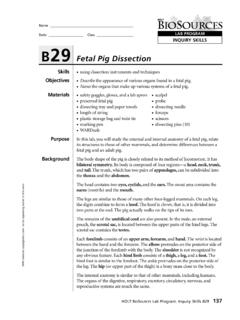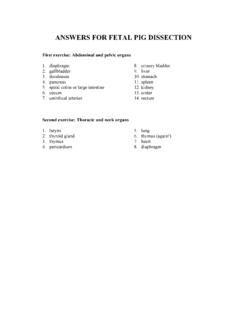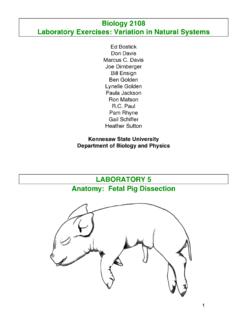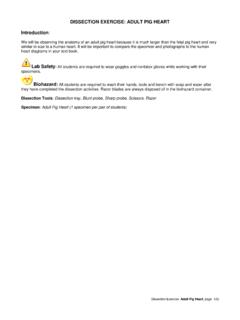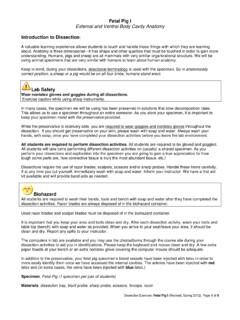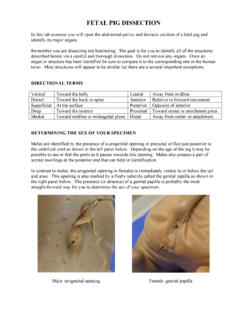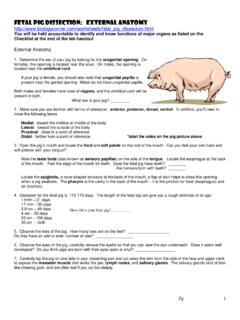Transcription of Fetal Pig Dissection Packet - mr.Powner.org
1 Page 1 of 9 Name _____ Period_____ * Each person will turn in his/her own Packet Fetal Pig Dissection Packet You may use the Virtual Fetal Pig Dissection website from Whitman College as a visual reference for all stages of Dissection . The URL is **Make sure you know the locations of all the bold words on this handout** Fetal Pig Dissection : External Anatomy 1. Determine the sex of your pig by looking for the urogenital opening. On females, this opening is located near the anus. On males, the opening is located near the umbilical cord. If your pig is female, you should also note that urogenital papilla is present near the genital opening. Males do not have urogenital papilla. Both males and females have rows of nipples, and the umbilical cord will be present in both. What sex is your pig? _____ 2. Make sure you are familiar with anatomical terms of reference. These are for communicating with others when discussing parts of anatomy.
2 Anterior: toward the head Posterior: toward the tail Dorsal: toward the back-side Ventral: toward the belly-side Medial: toward the midline or middle of the body Lateral: away from the midline or toward the side of the body Proximal: close to a point of reference Distal: farther from a point of reference *Call an instructor to your table to demonstrate knowledge of these terms 3. Open the pig s mouth. You may need to cut the muscle that holds the jaws together on both sides. Locate the hard and soft palate on the roof of the mouth. Can you feel your own hard and soft palates with your tongue? Note the taste buds (also known as sensory papillae) on the side of the tongue. Locate the esophagus at the back of the mouth. Feel the edge of the mouth for teeth. Does the Fetal pig have teeth? _____ Are humans born with teeth? _____ Locate the epiglottis, a cone-shaped structure at the back of the mouth, a flap of skin helps to close this opening when a pig swallows.
3 The pharynx is the cavity in the back of the mouth it is the junction for food (esophagus) and air (trachea). Page 2 of 9 4. Gestation for the Fetal pig is 112-115 days. The length of the Fetal pig can give you a rough estimate of its age. 11mm 21 days 17 mm 35 days cm 49 days 4 cm 56 days 22 cm 100 days 30 cm -- birth 5. Observe the toes of the pig. How many toes are on the feet? _____ Do they have an odd or even number of toes? _____ 6. Observe the eyes of the pig, carefully remove the eyelid so that you can view the eye underneath. Does it seem well developed? Do you think pigs are born with their eyes open or shut? _____ 7. Carefully lay the pig on one side in your dissecting pan and cut away the skin from the side of the face and upper neck to expose the masseter muscle that works the jaw, lymph nodes, and salivary glands. The salivary glands kind of look like chewing gum, and are often lost if you cut too deeply.
4 Fetal Pig Dissection : Abdominal Cavity In this activity, you will open the abdominal and thoracic cavity of the Fetal pig and identify structures. Remember, that to dissect means to "expose to view" - a careful Dissection will make it easier for you to find the organs and structures. Be sure to follow all directions. The Incision Place your Fetal pig in the dissecting pan ventral side up. Use string to "hog-tie" your pig so that the legs are spread eagle and not in your way. Use scissors to cut through the skin and muscles according to the diagram. Do not remove the umbilical cord. In the first section, you will only examine the abdominal cavity (the area below the ribcage). After completing the cuts, locate the umbilical vein that leads from the umbilical cord to the liver. You will need to cut this vein in order to open up the abdominal cavity. Your pig may be filled with water and preservative, drain over the sink if necessary and rinse organs.
5 Locate each of the organs below, check the box. 1. Diaphragm. This muscle divides the thoracic and abdominal cavity and is located near the ribcage. The diaphragm aids in breathing. 2. Liver. This structure is lobed and is the largest organ in the body. The liver is responsible for making bile for digestion. 3. Gall bladder. This greenish organ is located underneath the liver; the bile duct attaches the gall bladder to the duodenum. The gall bladder stores bile and sends it to the duodenum, via the bile duct. 4. Stomach. A pouch shaped organ that rests just underneath and to the pig's left. At the top of the stomach, you'll find the esophagus. The stomach is responsible for churching and breaking down food. How old is your Fetal pig? _____ Page 3 of 9 5. At each end of the stomach are valves that regulate food entering and leaving the stomach. At the esophagus is the cardiac sphincter valve, and at the duodenum is the pyloric sphincter valve.
6 View the inside of the stomach by slicing it open lengthwise. 6. The stomach leads to the small intestine, which is composed of the duodenum (straight portion just after the stomach) and the ileum (curly part). 7. The ileum is held together by mesentery. In the small intestine, further digestion occurs and nutrients are absorbed through the arteries in the mesentery. These arteries are called mesenteric arteries. 8. Pancreas: a bumpy organ located along the underside of the stomach, a pancreatic duct leads to the duodenum. The pancreas makes insulin, which is necessary for the proper uptake of sugars from the blood. 9. Spleen: a flattened organ that lies across the stomach and toward the extreme left side of the pig. The spleen stores blood and is not part of the digestive system. On the underside of the spleen, locate the splenic artery. 10. At the end of the ileum, where it widens to become the large intestine, a "dead-end" branch is visible.
7 This is the cecum. The cecum helps the pig digest plant material. 11. The large intestine can be traced to the rectum. The rectum lies toward the back of the pig and will not be moveable. The rectum opens to the outside of the pig, or the anus. The large intestine reabsorbs water from the digested food, any undigested food is stored in the rectum as feces. 12. Lying on either side of the spine are two bean shaped organs: the kidneys. The kidneys are responsible for removing harmful substances from the blood, these substances are excreted as urine. (more on this later) 13. Two umbilical vessels can be seen in the umbilical cord, and the flattened urinary bladder lies between them. 14 24 label the digestive organs on the diagram of the abdominal cavity Page 4 of 9 Identify the organ (or structure) from its function. Use whichever reference you prefer. 25. _____ Opening (valve) between stomach and small intestine. 26. _____ Stores bile, lies underneath the liver.
8 27. _____ A branch of the large intestine, a dead end. 28. _____ Separates the thoracic and abdominal cavity; aids breathing. 29. _____ Membrane that holds the coils of the small intestine. 30. _____ The straight part of the small intestine just after the stomach. 31. _____ Empties bile into the duodenum from the gall bladder. 32. _____ The last stretch of the large intestine before it exits at the anus. 33. _____ Bumpy structure under the stomach; makes insulin 34. _____ Lies between the two umbilical vessels. Fetal Pig Dissection : Urinary and Reproductive Systems 35. Locate the kidneys; the tubes leading from the kidneys that carry urine are the ureters. 36. The ureters carry urine to the urinary bladder - located between the umbilical vessels. 37. Lift the bladder to locate the urethra, the tube that carries urine out of the body. 38. Note the vessels that attach to the kidney these are the renal vessels Male 39. Find the scrotal sacs at the posterior end of the pig (between the legs) 40.
9 A testis is located in each sac. Open the scrotal sac to locate the testis. 41. On each teste, find the coiled epididymis. Sperm cells produces in the teste pass through the epididymis and into a tube called the vas deferens (in humans, a vasectomy involves cutting this tube). 42. The penis can be located by cutting away the skin on the flap near the umbilical cord. This tube-like structure eventually exits out the urogenital opening, also known as the urethra. Female 43. In the female pig, locate two bean shaped ovaries located just posterior to the kidneys and connected to the curly oviducts. 44. Trace the oviducts toward the posterior to find that they merge at the uterus. 45. Trace the uterus to the vagina. The vagina will actually will appear as a continuation of the uterus. Page 5 of 9 46 56 Label the diagrams (Identify the male and the female) Page 6 of 9 Fetal Pig Dissection : Thoracic Cavity 57. Find the diaphragm again.
10 Remember that the diaphragm separates the abdominal cavity from the thoracic cavity and it aids in breathing. Above the diaphragm, center of chest, is the heart. 58. Push the heart to the side to locate two spongy lungs located to the left and right side. The lungs are connected to bronchial tubes (not visible) which connect to the trachea (forming a Y). 59. The trachea is easy to identify due to the cartilaginous rings, which help keep it from collapsing as the animal inhales and exhales. The trachea should be located in the chin area above the heart. 60. Laying atop the trachea, locate the pinkish-brown, V shaped structure called the thyroid gland. This gland secretes hormones that control growth and metabolism. 61. At the anterior (toward head) of the trachea, you can find the hard light colored larynx (or voice box). The larynx allows the pig to produce sounds - grunts and oinks. 62 68 Identify the structures of the thoracic cavity from their descriptions on the previous page.
